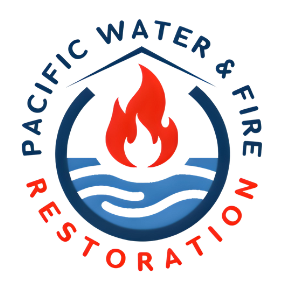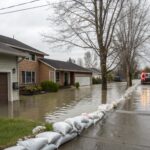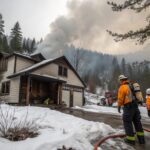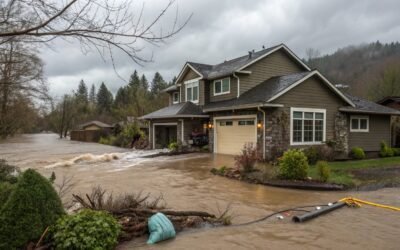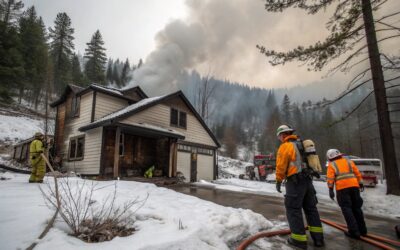The Columbia River is the lifeblood of the Pacific Northwest, supporting ecosystems, commerce, and communities across Oregon and Washington. For Vancouver residents, living near this majestic waterway offers stunning views and recreational opportunities. However, it also comes with periodic flooding risks that can threaten homes and businesses.
At Pacific Water & Fire Restoration, we’ve helped countless property owners recover from water damage caused by Columbia River flooding. More importantly, we’ve learned that preparation is the most effective way to minimize damage and protect what matters most. This guide will provide Vancouver residents with practical strategies to prepare for potential flooding events.
Understanding Columbia River Flood Risks in Vancouver
The Columbia River Basin drains more than 258,000 square miles, with spring snowmelt and heavy rainfall events being the primary causes of flooding. While modern dam systems have reduced catastrophic floods, seasonal high-water events still pose significant risks to properties in low-lying areas of Vancouver.
Key Flood Risk Factors for Vancouver Residents
- Spring Snowmelt: Typically occurring between April and June, when mountain snowpack melts rapidly
- Heavy Rainfall Events: Particularly during atmospheric river events in fall and winter
- Urban Development: Increased impervious surfaces reduce natural drainage
- Location Relative to Floodplain: Properties in the 100-year and 500-year floodplains face elevated risk
According to FEMA flood data, approximately 15% of Vancouver properties lie within designated flood zones, with areas near Vancouver Lake, Salmon Creek, and downtown waterfront districts experiencing the highest risk.
Early Warning Signs of Potential Flooding
Being alert to early warning signs can provide crucial time for preparation:
- Sustained heavy rainfall over multiple days
- Rapid snowmelt combined with rain events
- River gauge levels approaching flood stage (15.0 feet at the Vancouver gauge)
- Flood warnings issued by the National Weather Service
- Increased water release from upstream dams
- Unusually saturated ground that’s unable to absorb more water
Pro Tip: Sign up for Clark County emergency alerts and monitor the USGS river gauge readings online for real-time information about Columbia River water levels.
Essential Preparation Steps Before a Flood
1. Know Your Flood Risk
Before making specific preparations, determine your property’s flood risk level:
- Check FEMA flood maps at floodsmart.gov
- Review historical flood data for your neighborhood
- Consult with local Vancouver emergency management officials
- Understand your elevation relative to flood stage levels
2. Develop a Comprehensive Flood Plan
A well-thought-out plan is crucial for protecting your property and family:
- Create an evacuation plan with multiple routes
- Establish a communication strategy for family members
- Identify a safe meeting location away from flood-prone areas
- Prepare an emergency kit with essentials (detailed below)
- Document important contact information for emergency services
- Plan for pets and livestock if applicable
3. Prepare an Emergency Kit
Your emergency kit should include:
- Three-day supply of non-perishable food
- Three gallons of water per person
- Battery-powered radio and extra batteries
- Flashlights and light sticks
- First aid supplies
- Essential medications
- Copies of important documents in waterproof containers
- Cash and emergency contact information
- Hygiene and sanitation supplies
- Warm clothing and blankets
4. Protect Important Documents
Flooding can destroy critical paperwork. Secure the following:
- Insurance policies
- Property deeds and mortgage documents
- Birth certificates and passports
- Medical records
- Financial account information
- Family photos and irreplaceable memorabilia
Store these items in waterproof containers on upper floors or consider a safety deposit box outside the flood zone.
Property Protection Measures
1. Structural Preparations
Consider these permanent modifications to reduce flood damage:
- Elevate your home above base flood level if feasible
- Install check valves in plumbing to prevent backups
- Waterproof basement walls with sealants
- Improve lot grading to direct water away from foundations
- Install a sump pump system with battery backup
- Create permanent barriers where appropriate (levees, floodwalls)
2. Temporary Flood Protection
When flooding is imminent:
- Use sandbags strategically around entry points (Clark County often provides free sandbags during flood events)
- Apply waterproof sealant around doors, windows, and foundation cracks
- Install flood shields for doors and windows
- Move valuable items to higher floors
- Create temporary barriers with plastic sheeting and duct tape
- Elevate furniture on concrete blocks
Safety Warning: Never stack sandbags more than three feet high without professional guidance, as improper stacking can create dangerous structural pressures.
3. Utility Preparations
Protect your home’s systems with these steps:
- Learn how to safely shut off electricity, gas, and water
- Elevate electrical system components (switches, sockets, circuit breakers)
- Anchor and elevate fuel tanks securely
- Move washers, dryers, and water heaters to higher locations if possible
- Install floating floor drains to prevent sewer backups
4. Landscaping Strategies for Flood Mitigation
Your yard can be your first line of defense:
- Plant native vegetation that absorbs water effectively
- Create rain gardens in strategic locations
- Use permeable materials for driveways and walkways
- Maintain clean gutters and downspouts
- Direct downspouts away from foundations
- Consider bioswales for properties with significant runoff
Insurance Considerations for Vancouver Residents
Standard homeowners insurance typically doesn’t cover flood damage. Consider these insurance steps:
- Purchase separate flood insurance through the National Flood Insurance Program (NFIP) or private insurers
- Understand that flood policies typically have a 30-day waiting period
- Document pre-flood condition of property with photos and videos
- Create a detailed inventory of belongings with values
- Review policy details to understand what is and isn’t covered
- Consider additional coverage for basements or high-value items
According to FEMA, just one inch of floodwater can cause up to $25,000 in damage to a home. Proper insurance coverage is essential for financial protection.
During a Flood: Critical Safety Guidelines
If flooding occurs despite precautions:
- Prioritize safety over property protection
- Follow all evacuation orders immediately
- Avoid walking or driving through floodwaters (just 6 inches of moving water can knock you down)
- Stay away from downed power lines
- Avoid bridges over fast-moving water
- Move to higher ground whenever possible
- Monitor emergency broadcasts for updates
Emergency Contact: If you’re trapped by floodwaters, call 911 immediately.
After the Flood: Initial Recovery Steps
Once waters recede and authorities indicate it’s safe to return:
- Document Everything: Take extensive photos and videos before cleanup
- Contact Your Insurance: Report damage immediately
- Safety Assessment: Check for structural damage before entering
- Utility Safety: Have professionals inspect electrical, gas, and water systems
- Water Removal: Begin water extraction as soon as possible
- Contamination Concerns: Treat all floodwater as potentially contaminated
- Mold Prevention: Start drying process within 24-48 hours to prevent mold growth
Professional Restoration Services
While DIY cleanup may seem cost-effective, professional restoration services offer several advantages:
- Industrial-grade water extraction equipment
- Scientific drying techniques to prevent secondary damage
- Professional sanitization of contaminated areas
- Expert assessment of hidden damage
- Proper disposal of contaminated materials
- Coordination with insurance adjusters
- Complete documentation for claims
- Comprehensive structural drying to prevent mold
Pro Tip: The first 24-48 hours after flooding are critical for preventing mold growth. Professional water damage restoration services can significantly reduce long-term damage through rapid response.
Community Resources for Vancouver Residents
Vancouver offers several resources to help residents prepare for and recover from flooding:
- Clark County Emergency Management: Flood preparedness information and alerts
- Clark Regional Emergency Services Agency (CRESA): Coordination during emergencies
- City of Vancouver Public Works: Sandbag distribution during flood events
- American Red Cross Southwest Washington Chapter: Emergency shelter and supplies
- Vancouver Watershed Alliance: Flood mitigation resources and education
- Clark Public Utilities: Guidance on utility safety during floods
Lessons from Past Columbia River Floods
The 1996 flood remains one of the most significant recent flooding events in Vancouver’s history, causing millions in property damage. Key lessons include:
- Early evacuation saves lives
- Properties with flood-specific preparations experienced less damage
- Communities with strong emergency plans recovered faster
- Professional water damage restoration significantly reduced long-term issues
- Properties with proper flood insurance recovered financially more quickly
- Homes with elevated utilities sustained less system damage
Conclusion: Building Flood Resilience in Vancouver
Living near the Columbia River comes with inherent flood risks, but proactive preparation can significantly reduce potential damage. By understanding your flood risk, creating a comprehensive plan, implementing property protection measures, and knowing what to do during and after a flood event, Vancouver residents can build resilience against flooding challenges.
Remember that preparation is an ongoing process. Regularly review and update your flood plan, maintain protective measures, and stay informed about changing flood risks in your area.
How Pacific Water & Fire Restoration Can Help
As Clark County’s trusted restoration professionals, Pacific Water & Fire Restoration offers comprehensive services to help Vancouver residents prepare for and recover from Columbia River flooding:
- 24/7 Emergency Response: Available day or night at 503-201-7337
- Free Flood Preparedness Assessments: Professional evaluation of your property’s flood vulnerabilities
- Water Damage Restoration: Complete extraction, drying, and restoration services
- Mold Remediation: Professional removal of flood-related mold growth
- Structural Drying: Scientific drying techniques to prevent secondary damage
- Content Restoration: Specialized cleaning for water-damaged belongings
- Insurance Coordination: Assistance working with your insurance provider
Don’t wait until floodwaters rise to protect your Vancouver property. Contact our IICRC-certified professionals today for a free consultation on how to prepare your home or business for potential Columbia River flooding.
Call for Immediate Assistance: 503-201-7337
Pacific Water & Fire Restoration is fully licensed, bonded, and insured, serving Vancouver, Portland, and surrounding communities with 24/7 emergency restoration services.
